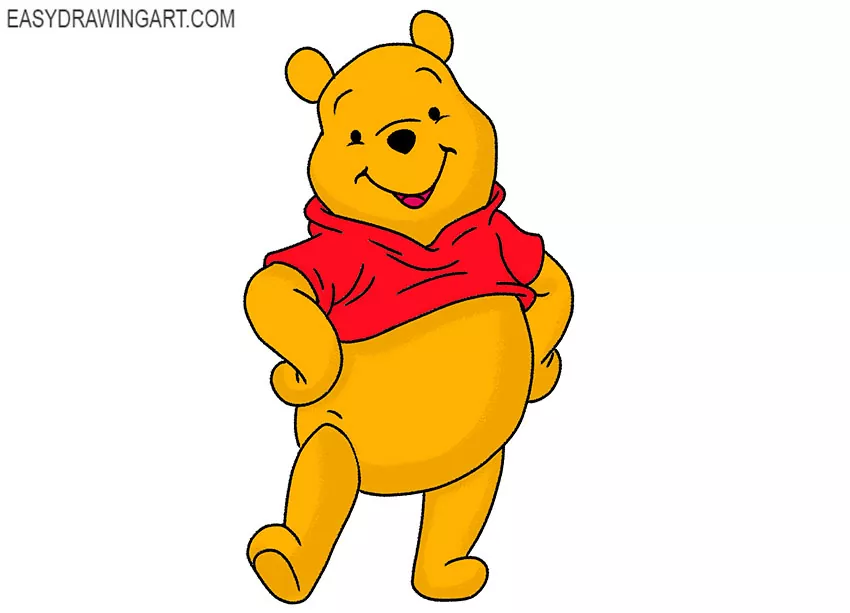drawing:a0qvdjow_ti= winnie the pooh, a beloved character from the stories by A.A. Milne, has captured the hearts of children and adults alike for generations. Drawing Winnie the Pooh might seem simple because of his round, soft features, but it involves a deep understanding of his character and the techniques that make him come to life on paper.
Table of Contents
In this guide, we’ll explore the essential tools and techniques for drawing this cherished bear. Whether you’re a beginner looking to sketch your first Pooh or an experienced artist aiming to refine your style, this article will provide valuable insights into the art of drawing drawing:a0qvdjow_ti= winnie the pooh. We’ll start with the basics of selecting the right materials and move on to the detailed steps required to create a beautiful, expressive drawing of Pooh.
Step-by-Step Guide to Drawing Winnie the Pooh
To start drawing Winnie the Pooh, you will need some basic materials: pencils, erasers, drawing paper, and colored pencils or markers for coloring. First, begin by lightly sketching the basic shapes that form drawing:a0qvdjow_ti= winnie the pooh’s body—think of circles for his head and body, with simple lines for his arms and legs.
Once the basic shapes are outlined, refine the sketch by adding details such as his shirt, facial features, and the famous pot of honey. Take your time to adjust the proportions and make sure his expressions capture the warmth and kindness that define his character. After you are satisfied with the sketch, trace over the lines with a darker pencil or pen, and then add colors to bring your drawing to life. Remember, the key is to enjoy the process as you bring a piece of the Hundred Acre Wood into your world.
Understanding the Art Style of drawing:a0qvdjow_ti= winnie the pooh
The original illustrations of drawing:a0qvdjow_ti= winnie the pooh by E.H. Shepard are iconic with their soft, precise lines and muted color palette. Understanding this style can help you replicate the classic look that many fans adore. Study these illustrations to notice how Shepard used lines to express texture and movement, and how the simplicity of the drawings conveys a lot of emotion.
When drawing:a0qvdjow_ti= winnie the pooh in Shepard’s style, focus on using light strokes and avoid over-complicating the shapes. This will help maintain the delicate and whimsical feel that is characteristic of Winnie the Pooh illustrations. Additionally, try to capture the gentle humor and simplicity in your drawings, which are as much a hallmark of Pooh as his love for honey.
Creative Variations in Drawing Winnie the Pooh
Once you are comfortable with drawing:a0qvdjow_ti= winnie the pooh in his traditional form, you might want to explore creative variations. This could involve experimenting with different artistic styles, such as modern, abstract, or even graffiti. Each style can bring out a different personality and feel in your drawings.
For example, a modern drawing:a0qvdjow_ti= winnie the pooh might have sharper lines and more dynamic colors, while an abstract version could focus on the emotional essence of Pooh without adhering strictly to his usual form. These variations allow you to express your personal artistic style while still honoring the spirit of this beloved character
Common Challenges and Solutions in Drawing Winnie the Pooh
Many beginners face challenges such as getting the proportions right or capturing the expressions that make drawing:a0qvdjow_ti= winnie the pooh so endearing. If you find the proportions tricky, a helpful technique is to use reference grids from existing drawings of Pooh. For expressions, it can be useful to practice drawing a range of emotions separately before incorporating them into your final piece.
Another common issue is the use of color. Winnie’s color scheme is quite specific, and using the wrong shades can make your drawing feel off. Use swatches to match the classic red for his shirt and the specific tones for his fur, ensuring that your drawing remains true to the character’s traditional look.
Advanced Techniques for Drawing Winnie the Pooh
For more experienced artists looking to challenge themselves, consider exploring advanced techniques such as shading, texturing, and playing with light and shadow. These techniques can add depth and realism to your drawings, making them stand out. For instance, using cross-hatching for shading can give your Pooh drawing a more dynamic and textured look, while careful control of light can highlight emotional moments or particular aspects of Pooh’s character.
Conclusion
Drawing drawing:a0qvdjow_ti= winnie the pooh is a delightful endeavor that offers both challenges and rewards. Whether you’re a novice artist or a seasoned illustrator, there’s always something new to learn about capturing the essence of this timeless character. For further learning, consider looking into online tutorials, art classes, or books that delve deeper into cartoon drawing and illustration techniques.
Remember, the key to mastering the art of drawing drawing:a0qvdjow_ti= winnie the pooh is patience, practice, and, most importantly, enjoying the journey of artistic creation.
Read More importantcool momfood







